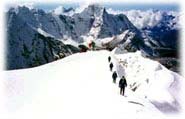
|
HOME |
NEWS |
REDIFF DIARY
|
Kanamma |
 What is it like fighting on the roof the world? The New York Times ran an illuminating vignette as India and Pakistan do battle over Siachen Glacier, and his account may well apply to the next skirmish point, Kargil. Wrote Barry Bearak: For a soldier, the 46-mile river of slow-moving ice surrounded by stupendous towers of snow is where hell freezes over. Rifles must be thawed over kerosene stoves, and machine guns primed with boiling water. At heights of 18,000 feet, mortar shells fly unpredictable and extraordinary distances, swerving erratically when met by sledgehammer gusts. Hostile fire is not the only danger, it seems. Far more soldiers perish from avalanches and missteps into crevasses that nature has camouflaged with snow. And, if one thought the end of winter is free of such perils, wrong. In springtime, the sun licks away several feet of ice and opens new underground cracks and seams. Since April 13, 1984, the Indian Army, thanks to a 'pre-emptive' move, controls the heights, holding on to the tactical advantage of high ground. What 15 years of eyeball-to-eyeball means, says Bearak, is the Pakistanis cannot get up to the glacier, while the Indians cannot come down.
The Indians are at the very start of the glacier, at home with barracks, helipads, supply sheds, satellite dishes, a hospital and Hindu shrines. The command post is carpeted. Curtains hang along the windows. In contrast to the superior 'view' the Indian position commands, the Pakistanis, 'tis said, see nothing. In fact, the Indians scoffed to Bearak that their counterparts hear a chopper and shoot, hear artillery and shoot, without knowing where they are shooting. Where the Pakis score is in logistical detail. While they can re-supply most of their posts by road and pack mule, Indians rely on helicopters. At the most practical level, the biggest enemy is the cold. At such Himalayan heights, hot water bottles do not stay hot for long, and a relay must be set up to exchange frozen rifles for defrosted ones, says the NYT. ''At my post, you have to use a crawl trench to get to the toilet," said Corporal Joginder Singh. ''When it snows, the trench fills up and you have to stand. The enemy can see you and that's how you die.''
The inscription reads: 'Quartered in snow, silent to remain. When the bugle calls, they shall rise and march again.' The story of why India moved in is interesting. While maps printed in the West were starting to show Siachen as part of Pakistan, in late 1983, Indians got to know of Pakistan's design through intercepted communiques. And when India sent a delegation to Europe to pick up cold-weather gear, further surprise awaited them when they found the Pakis just the same. Kalidas may not have lauded the nomenclature, but Operation Meghdoot, when India moved into the glacier, was not exactly well thought out. Initially keen on staying only the winter, Indians soon realised that it was easier than done, unless they wanted to hand over the area to Pakistan. Thus started the year-round holding operation.
With both the countries being predominantly tropical, high altitude was something like a learn-on-the-job experience. Casualties soared, frostbite, snow blindness and pulmonary
and cerebral edema all took a huge toll.
Just consider, even sweat becomes a problem because it becomes ice in a soldier's gloves and socks. Frostbite is then quick with its work. Appetites go for a toss, and even if it doesn't, there is no cordon bleu around: tin cans are the sole source of sustenance. An orange freezes to a baseball; while even Bofors would be hard put to smash a potato. Still, the two sides have dug their heels in, the conquest of the elements continuing apace. India is building a kerosene pipeline, and a ski lift to ferry soldiers. For supplies, there is a pulley system put in place, as well as bacterial disposal of human waste. All this experience must come in handy at the Kargil heights as well.
Kanamma often contributes to these pages.
|
||
|
HOME |
NEWS |
BUSINESS |
SPORTS |
MOVIES |
CHAT |
INFOTECH |
TRAVEL |
SINGLES BOOK SHOP | MUSIC SHOP | GIFT SHOP | HOTEL RESERVATIONS | WORLD CUP 99 EDUCATION | PERSONAL HOMEPAGES | FREE EMAIL | FEEDBACK |
||
 Admits General Khalid Mehmood
Arif, the
retired former vice-chief of Pakistan's military, to the NYT. ''No
nation ever
wants to lose a single inch of territory, so Siachen has
psychological and
political importance. Its value is in ego and prestige.''
Admits General Khalid Mehmood
Arif, the
retired former vice-chief of Pakistan's military, to the NYT. ''No
nation ever
wants to lose a single inch of territory, so Siachen has
psychological and
political importance. Its value is in ego and prestige.''
 Of death in the heights, there is little record. While Pakistan holds such detail close to their chest, India says they have lost only the 616 soldiers whose
names appear on
a stone memorial at the base camp.
Of death in the heights, there is little record. While Pakistan holds such detail close to their chest, India says they have lost only the 616 soldiers whose
names appear on
a stone memorial at the base camp.
